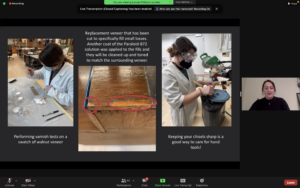Emerging Professionals Talks (March 3, 2022)
Presented by Williston Fund Recipient: Lauren Phillips, Pre-program Intern at the Baltimore Museum of Art and the Museum of Fine Arts, Boston
In March, WCG was joined by four emerging professionals from the DC area who shared with us a few of their experiences in treatment, research, and analytical imaging. Our first speaker was Lauren Phillips, who brought us “Practicing Treatment and Analysis Methods through Reproduction Furniture: A Pre-Program Introduction to Furniture Conservation at The Museum of Fine Arts, Boston.” During her time at the MFA Boston with Christine Storti, Greg Porter, and Yuqi Chock, Lauren participated in numerous projects to expand her conservation skills and knowledge. Of particular note were her treatment of a pair of skyscraper dressers designed by Paul Theodore Frankl and her analytical study of a prototype leg for a reproduction Bed of Queen Hetepheres I by William A. Stewart.
The skyscraper dressers presented with a delaminating cellulose nitrate coating and missing areas of veneer, which required stabilization before the object could be placed in storage. Lauren shared with us the process of consolidating the coating using a heated spatula, applied over a protective mylar barrier. The heat reactivated the coating and acted to readhere it to the objects’ surface. Then, Lauren used walnut veneer to patch and replace missing areas of veneer on the dressers. Lauren coated pieces of walnut veneer with Paraloid B-72 in xylene, which visually approximated the appearance of the original cellulose nitrate coating. Then, using mylar templates, she cut the veneers to fit the areas of loss. Lauren applied a hide glue barrier layer and used epoxy putty as a gap-filler between her veneers and the object surface. She adhered the veneers in place using hide glue.
Lauren went on to discuss her analysis of the prototype leg. In the first phase of this project, she performed provenance research for context. Lauren determined that the legs were likely constructed in 1927 to aid conservator William Arnold Stewart in the reproduction of the “Bed of Hetepheres I,” which had been excavated by a team in 1925. The leg is composed of a wooden core, which was set in a plaster cast. The leg has a gilt surface with an underlying layer of red bole. Due to poor adhesion between the plaster and wood core, the leg is currently unstable and fragmentary. Using UVA fluorescence imaging, Lauren was able to examine coatings and adhesives present on the object. She collected cross-section samples to identify the stratigraphy of the coating materials present and hypothesize their identity. In viewing the cross-sections under UVA light, the gilding size was visible in blue/green. Coupled with the visible qualities of the object, Lauren was able to conclude that the leg was oil-gilt. Before the conclusion of Lauren’s internship at the MFA Boston, she completed a condition assessment for the object so that future interns may pick up where she left off.
Lauren is applying to graduate programs this year, and is looking forward to continuing to explore furniture conservation. Owing to her background in art history, Lauren has particular interests in Medieval illuminated manuscripts, but she has also found recent interest in Federal-period card tables.
Meeting summary by: Jen Mikes Graduate Intern in Objects Conservation at the Walters Art Museum, SUNY Buffalo State College Class of 2022
Attendance: 62 participants
Venue: virtual
